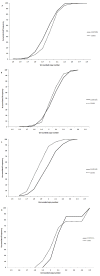Accuracy and differential bias in copy number measurement of CCL3L1 in association studies with three auto-immune disorders
- PMID: 21851606
- PMCID: PMC3166952
- DOI: 10.1186/1471-2164-12-418
Accuracy and differential bias in copy number measurement of CCL3L1 in association studies with three auto-immune disorders
Abstract
Background: Copy number variation (CNV) contributes to the variation observed between individuals and can influence human disease progression, but the accurate measurement of individual copy numbers is technically challenging. In the work presented here we describe a modification to a previously described paralogue ratio test (PRT) method for genotyping the CCL3L1/CCL4L1 copy variable region, which we use to ascertain CCL3L1/CCL4L1 copy number in 1581 European samples. As the products of CCL3L1 and CCL4L1 potentially play a role in autoimmunity we performed case control association studies with Crohn's disease, rheumatoid arthritis and psoriasis clinical cohorts.
Results: We evaluate the PRT methodology used, paying particular attention to accuracy and precision, and highlight the problems of differential bias in copy number measurements. Our PRT methods for measuring copy number were of sufficient precision to detect very slight but systematic differential bias between results from case and control DNA samples in one study. We find no evidence for an association between CCL3L1 copy number and Crohn's disease, rheumatoid arthritis or psoriasis.
Conclusions: Differential bias of this small magnitude, but applied systematically across large numbers of samples, would create a serious risk of false positive associations in copy number, if measured using methods of lower precision, or methods relying on single uncorroborated measurements. In this study the small differential bias detected by PRT in one sample set was resolved by a simple pre-treatment by restriction enzyme digestion.
Figures



References
Publication types
MeSH terms
Substances
Grants and funding
LinkOut - more resources
Full Text Sources
Medical
Research Materials

